ALFRED BARRETT BIGGS Transit of Venus 1874
CITY PHOTOGRAPHIC ESTABLISHMENT Thomas J. Nevin
The Biggs family
Abraham Biggs (1799-1875) was a builder and contractor from Bedford, England who arrived in Van Diemen's Land (Tasmania) in 1833 as a free settler with his wife Eliza Biggs née Coleman (1801-1891) and three sons aboard the Sir John Rae Reid. In Tasmania, Abraham and Eliza Biggs had a several more children up to and including the last, Laura Elizabeth Turner Biggs born in October 1845. Their daughter, Elizabeth Susannah Biggs who was born on 6th April 1838 at Jerusalem - a town in the central highlands region of Tasmania, one of several with Biblical place names, eg. River Jordan, Bagdad, Jericho - was baptised at the Wesleyan Church, Hobart on 25th December 1838. Her father's "trade or occupation" was registered as "catechist" (Baptisms in Tasmania, 1803-1862 (to no. 5364) RGD 32/1-32/4).
Both Abraham Biggs senior and his sons Alfred Barrett and Abraham Edwin alternated periods of residence at their properties in Victoria and Tasmania from the 1850s. With the death of Abraham Biggs senior in Melbourne in 1875, the lease on the studio and residence held by photographer Thomas J. Nevin since 1865 with his eldest son Abraham Edwin Biggs and operated as The City Photographic Establishment, 138-140 Elizabeth St. Hobart Town, was advertised at auction. A few portraits and stereographs taken for the Biggs family by Thomas J. Nevin are held in public collections.


On left: Abraham Biggs ca. 1870
Photographer: Paterson Brothers, East Melbourne
Source: Archives Office of Tasmania
View online: LMSS754-1-12
On right: Mrs Eliza Biggs, wife of Abraham Biggs early 1870s
Photographer: Thomas J. Nevin, City Photographic Establishment, Hobart
Source: Archives Office of Tasmania
View online:LMSS754-1-10
On 20th December 1852, three years before his marriage to Harriet Burville in 1855, Alfred Barrett Biggs left Launceston on the Yarra Yarra bound for Melbourne where he continued working as a bank clerk. He arrived just a few weeks after the quarantine of the female emigrant ship Bombay on which 24 deaths had occurred during the voyage, four from typhus fever.

Left page: Biggs, A: Record Type:Departures
Title: Mr: Rank: Cabin
Departure date: 20 Dec 1852 Departure port: Launceston
Ship: Yarra Yarra Ship to colony: Sir John Rae Reid
Bound to: Melbourne Record ID: NAME_INDEXES:523302
Resource:POL220/1/2 p282
Deaths on the ship Bombay, Melbourne, December 1852.

Deaths on the ship Bombay, Melbourne December 1852
The Argus (Melbourne, Vic.) Wed 15 Dec 1852 Page 4 SHIPPING INTELLIGENCE.
TRANSCRIPT
The Bombay, ship, 1270 tons, Capt. Flamant, from London, 114 days out, with 706 Government Emigrants, anchored at the Heads on Saturday evening; from information received yesterday morn-ing it appears that 24 deaths had occurred on the voyage, two from drowning, four from typhus fever, (one of which occurred just on entering the Heads), the others from general diseases. This vessel came up off Gellibrand's Point, yesterday afternoon, with the quarantine flag flying at the main, and at the time the Health Officer left Williams Town, it was supposed she would be either sent to the quarantine anchorage off Brighton, or back to the sanitary station at Point Nepean.By whatever means, Alfred Biggs managed to obtain a gruesome relic from the death of a woman on the Bombay who was buried at sea. It is not at all clear in his note bearing a fragment of muslin with polka dots from her dress whether it was thrown overboard at the time of her burial, to be retrieved two weeks later when a shark attended another burial and was caught and cut open open to reveal the piece of dress material, or whether she was wearing the dress when she was consumed two weeks' earlier by the same shark. In any event, according to Alfred Biggs' note, the shark was cooked and eaten - by whom he doesn't say - except to say it tasted like eel. Alfred's barely disguised innuendo here is to suggest second-hand cannibalism.

Note from Alfred Biggs and piece of muslin dress. Cloth piece was thrown overboard and later retrieved from shark caught during funeral on the ship Bombay in 1852.
Item Number: NS5467/1/3
Archives Office Tasmania
TRANSCRIPT
"Piece cut from a length of Muslin (a width cut from a young persons dress, & thrown overboard) after an interval of a fortnight, taken out of a Shark, caught during a funeral at sea, on board the ship Bombay coming from England to Australia end of 1852.
Portion of said Shark, cooked, tasted very much like eel.
A.B. Biggs"
Triple Wedding, 22nd February 1855
The three sons of Abraham and Eliza Biggs née Coleman -
Alfred Barrett Biggs (1825–1900)
Abraham Edwin Biggs (1829-1899)
Isaac Henry Biggs (1831-1906)
- each married their respective brides all on the same day, February 22nd, 1855 in a triple wedding held at the Wesleyan Centenary Chapel, Melville-street, Hobart:-
Eldest son Alfred Barrett Biggs, bank clerk, married 20 yrs old Harriet Burvill (1834-1894).
Second son, Abraham Edwin Biggs, builder, married Eliza Burvill (1833-1881?)
Third son, Isaac Henry Biggs, draper, married Annie Hodgins (1832-1904)
Triple wedding; Biggs family
Source; Colonial Times (Hobart, Tas. : 1828 - 1857), Tuesday 27 February 1855, page 2
TRANSCRIPT
MARRIED.
BY special license, on Thursday last, the 22nd instant, at the Wesleyan Centenary Chapel, Melville-street, by the Rev. J. A Manton, Mr. ALFRED BARRETT BIGGS, eldest son of Mr. A. Biggs, Builder, of Melbourne, to HARRIET, second daughter of Mr. J. Burvill, of Elizabeth-street ; and at the same time and place, Mr. ABRAHAM EDWIN BIGGS, Builder, second son of Mr. A. Biggs, to ELIZA, eldest daughter of Mr. J. Burvill. and Mr. ISAAC HENRY BIGGS, third son of Mr. A. Biggs, to ANNIE, eldest daughter of Mrs. Hodgins, of Macquarie-street.
Source: Colonial Times (Hobart, Tas. : 1828 - 1857) Tue 27 Feb 1855 Page 2 Family Notices

Three certificates, three marriages, details of the first are:
Name: Biggs, Alfred Barrett
Record Type: Marriages
Gender: Male
Age: Adult
Spouse: Burville, Harriett
Gender: Female
Age: Minor
Date of marriage: 22 Feb 1855
Registered: Hobart
Registration year: 1855
Record ID: NAME_INDEXES:851923
Resource: RGD37/1/14 no 714 Archives Office Tasmania
The Burville sisters and their respective husbands - eldest daughter of Mr. J. Burville, Harriet who married Alfred Barrett Biggs, and second eldest daughter Eliza who married his brother Abraham Edwin Biggs - lived in a commodious two storey house in Burville Place, near the Toll-gate on New Town Road, Hobart, until mid 1857 when renovations on the kitchens and other improvements were completed. The house was then advertised to let;
Source: Colonial Times (Hobart, Tas. : 1828 - 1857) Thu 12 Mar 1857 Page 3 Advertising
TRANSCRIPT
WANTED a RESPECTABLE TENANT for "Burville Place," near the Toll-gate, New Town Road. Possession as soon as the new kitchens and other improvements are completed. Enquire of Mr. A. E. Biggs, on the premises or to Messrs. Mather and Son, Liverpool street.

Stereograph - Burville Place, New Town, Tasmania, bridal home of Alfred and Harriet Biggs and Edwin and Eliza Biggs, married on the same day in 1855.
Photographer: ?
Start Date: 01 Jan 1850
End Date: 31 Dec 1859
Source: Archives Office of Tasmania
View online LPIC147-3-171
Thomas Nevin at Bothwell and Campbell Town 1874
Eldest son Alfred Barrett Biggs with wife Harriet moved to Victoria in 1858 where he became headmaster of the Hoddle Street School, Melbourne but by 1864 they were back in Tasmania where Alfred took a teaching position at Bothwell. Their first five children were born in Melbourne.
By 1872 they had moved again to Campbell Town (Tasmania) where Alfred took another teaching post. There he met Dr William Valentine whose interest in astronomy resulted in a collaboration with a visiting American expedition headed by Charles Raymond to photograph the Transit of Venus from The Grange, Valentine's home, during December 1874. Alfred Biggs was given the building used by the Americans for the assistance he gave in the construction of the brick pier for the transit instrument and the wooden hut.
The New York Times published an account on 9th February, 1875, of the American expedition's visit to Tasmania to photograph the Transit of Venus in 1874. Read the full article here.
Photographers Samuel Clifford and Thomas Nevin met up with Alfred Biggs at Bothwell and Campbell Town on their travelling tour from Hobart to Launceston during the last stages of preparation for the visit by the American expedition, no doubt to inspect the impressive array of photographic instruments. This stereograph of the Templar's procession outside the school house at Bothwell was taken by Thomas J. Nevin while travelling with Samuel Clifford through the town on 26th September 1874. The notes accompanying this photograph now held at the Archives Office of Tasmania indicate the house, noted on Calder's map of 1847, was formerly occupied by Alfred Barrett Biggs, his wife and children, from 1864 to 1872.

Photographer: Thomas J. Nevin, Bothwell, September 1874
Source: State Library of Tasmania and TAHO
View online LPIC147-1-126
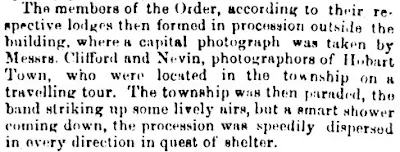
TRANSCRIPT
The members of the Order, according to their respective lodges then formed in procession outside the building, where a capital photograph was taken by Messrs Clifford and Nevin, photographers of Hobart Town, who were located in the township on a travelling tour. The township was then paraded, the band striking up some lively airs, but a smart shower coming down, the procession was speedily dispersed in every directions in quest of shelter.Samuel Clifford and Thomas Nevin in Bothwell
Source: Mercury 26 Sept 1874
Thomas Nevin at The City Photographic Establishment
The premises consisting of two house-and-shop properties owned by Abraham Biggs snr at No's 138-140 Elizabeth St. Hobart were still "unfinished" in 1853 according to the Hobart Valuation Rolls. By 1854 he was listed as the proprietor with his son, builder Abraham Edwin Biggs. By 1857 they had let the premises at No. 140 Elizabeth St. to photographer Alfred Bock which he operated as a studio with his (step) brother William Bock until 1865. On Alfred Bock's departure to Victoria, commercial photographer and government contractor Thomas J. Nevin continued the business with the firm's name, The City Photographic Establishment, 140 Elizabeth Street, Hobart Town, vacating the shop; residence, glass house and studio a decade later, in 1876, to take up his appointment in full-time civil service with residency at the Hobart Town Hall. Married in 1871, by 1874 Thomas Nevin had installed his wife Elizabeth Rachel Nevin née Day and their first two children (Mary Florence Elizabeth aka "May" b. 1872 and Thomas James jnr aka "Sonny" b. 1874) in the residence next to the studio. Elizabeth's father, master mariner Captain James Day, also resided there with the family while on shore in 1874. Thomas Nevin maintained his New Town studio (where he had first opened his professional practice in 1864) concurrently with his commercial practice at The City Photographic Establishment, Elizabeth St. from ca. 1865-1876. He entrusted his commercial stock to his close friend and colleague Samuel Clifford while working for the Hobart City Council at the Hobart Town Hall in residence from 1876-1880, returning to professional photography at New Town in 1881 until retirement in 1886-88.


Alfred Bock's studio stamp design and Thomas Nevin's adaptation after 1865
City Photographic Establishment, 140 Elizabeth St. Hobart Town
Copyright © Private Collections ARR 2007-2019
Alfred Bock was declared insolvent in 1865 and abruptly departed Tasmania, financially bruised by a dispute with photographer Henry Frith about the origins and rights to the sennotype process, His (half) brother William Bock departed for NSW, arriving in New Zealand in 1868. On 2nd August 1865 the stock-in-trade of Alfred Bock at the City Photographic Establishment was advertised for auction. The sale included a glass house which Bock and Nevin had installed at the end of the laneway adjacent to the studio, listed variously as 138½ or 136½ Elizabeth St. on valuation rolls.
TRANSCRIPT
This DaySource: Notice of auction of Alfred Bock's stock in trade, Mercury, 2 August 1865.
WEDNESDAY, 2nd August
at 11 o'clock
On the premises, 140 Elizabeth-street, nearly opposite the town residence of Henry Hopkins, Esq.
Stock-in-Trade of a Photographer
ALSO
Large Glass Studio, Shop Fittings, Oil Paintings, &c.
W.A. GUESDON & CO.
Have received instructions from John Milward, Esq, Assignee to the estate of Mr. Alfred Bock, to sell by auction, on the premises, Elizabeth-street, on THIS DAY, 2nd August, at 11 o'clock
THE STOCK-IN-TRADE of a Photographer, comprising -
Instruments, Chemicals, Background, accessories, chairs, tables, pedestals, vases, and many other necessary articles for taking photographic portraits, &c., &c.,
ALSO
A large and exceedingly well furnished glass house, 22 feet by 8 feet, with dark room attached,
AND
A few choice oil paintings in gilt frames, show cases, and photographs, an a small collection of books.
Terms - Cash
Views
Front and rear views of Thomas Nevin's shop, studio, glass house, gallery and residence at No's 138-140 Elizabeth St. 1860s-70s.

A view of Thomas Nevin's studio and shop, extreme right of frame, 140 Elizabeth St. Hobart
Stereograph by T. J. Nevin ca. 1867-70 of the City Photographic Establishment
The dark building next door at 138 Elizabeth St., Nevin's residence, was leased from A. E. Biggs
T. Nevin impress on lower centre of mount.
The Tasmanian Museum and Art Gallery Collection TMAG Ref: Q1994.56.12

Another view of Thomas Nevin's studio and shop, extreme right of frame, at 140 Elizabeth St. Hobart
The dark building next door at 138 Elizabeth St., Nevin's residence, was leased from A. E. Biggs
Stereograph by T. J. Nevin ca. 1867-1870 of the City Photographic Establishment
TMAG Ref: Q1994-56-33

Archives Office Of Tasmania
Detail of larger photograph - see below and online at PH1/1/35, unattributed, 1870
The Royal Standard Hotel at 142 Elizabeth St. Hobart, cnr of Patrick St.
Thomas Nevin's studio, glass house and residence, 140 -138 Elizabeth St. Hobart
Elizabeth St north 1870: the callouts show the rear of the Royal Standard Hotel on the corner of Patrick St. at 142 Elizabeth St. Hobart and the building next door at No. 140 (James Spence, licensee of the hotel from 1862). The path at viewer's left of the hotel leads upwards to the Trinity burial ground, located at the rear of Holy Trinity Church which has its entrance in Patrick St. Next door to the Royal Standard, looking down Elizabeth St. towards the River Derwent, is Nevin's shop front and studio, advertised as his business address, The City Photographic Establishment, 140 Elizabeth St.(half of house and shop front leased from James Spence). At the rear of 140 Elizabeth is the glass house which included a gallery, listed as 138½ Elizabeth St. and accessed by a side cart path, the property of A. E. Biggs. Next door (heading further down Elizabeth St towards the wharves) is Nevin's family residence, the dark building at 138 Elizabeth St. Hobart, which was listed as “unfinished” in 1853 together with the building at 140 Elizabeth St. according to the Hobart Valuation Rolls, but by 1854, both properties were listed in the names of Abraham Biggs and his son, builder Abraham Edwin Biggs. They were the lessors of glass house, studio and residence, firstly to Alfred Bock (1856-1865) and then to Thomas Nevin (1865-1876). James Spence transferred the indentures on the Royal Standard Hotel at 142 Elizabeth St, and the cottage and shop at 140 Elizabeth St. to John Henry Elliott in January 1874. Abraham Edwin Biggs was still the lessor of 138 Elizabeth St. in 1878, selling up to Catherine Peck in 1886.

Detail showing the Royal Standard Hotel at 142 Elizabeth Street, Hobart, proprietor James Spence; the City Photographic Establishment, shop and studio and glass house and gallery at rear accessed by a side cart path, 140 Elizabeth Street, Hobart, and residence at 138 Elizabeth St., residence and business of photographer Thomas J. Nevin 1867-1876.
Detail of NS1013-1-522
Source: Archives Office of Tasmania
Title: Hobart from from the intersection of Union Street and Devonshire Square, West Hobart, looking eastwards
Item Number: NS1013/1/522
Start Date: 01 Jan 1890
Source: Archives Office of Tasmania
Creating Agency: Pretyman Family (NG1012) 17 Aug 1892
The Hobart Valuation Rolls for 1872 shown here indicate that James Spence was the owner and occupier the Royal Standard Hotel at 142 Elizabeth St.plus the owner of the premises at 140 Elizabeth, occupied by Edward Slide. Thomas Nevin is shown as the occupier of part of dwelling house and shop at 138½ Elizabeth Street, and occupier of the dwelling house at 138 Elizabeth St., both owned by Abraham E. Biggs of Victoria who is also shown as the owner of 136½ Elizabeth St. occupied by Mrs Wilson. At some point, possibly when the glass house and gallery at the rear of 138 Elizabeth St was sold to Stephen Spurling elder in 1875, the lot listed as 138½ Elizabeth Street reverted to the main house, the dark building in the photos taken between 1868-1870. Thomas Nevin and family were gone from A. E. Biggs's property here at 138 Elizabeth St. by December 1876. They were newly installed in the Keeper's apartments at the Hobart Town Hall.
A decade later, in 1885, another of Abraham Biggs' properties was leased to Thomas Nevin and his family, the house at No. 82 Warwick Street. He had purchased it as Lot 6 from George Salier in 1851 who had purchased it as part of the entire ground comprising George Augustus Robinson's original 1836 grant on the corner of Elizabeth and Warwick Streets.
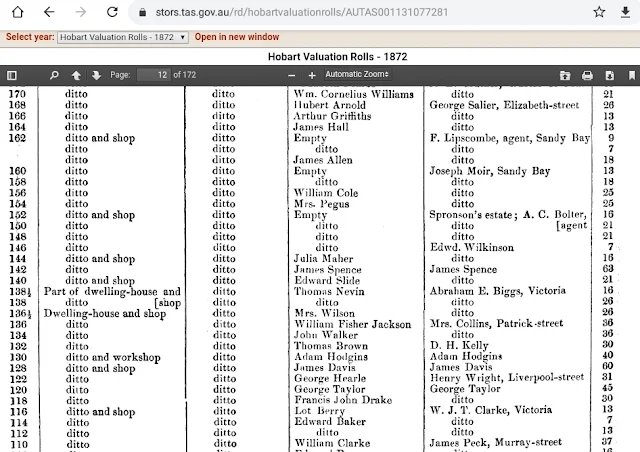
Screenshot: Hobart Valuation Rolls 1872
Archives Office Tasmania (link viewable at top of shot)

Description: Photograph - Hobart - view from North Hobart (Swan's Hill) - looking north
Item Number: PH1/1/35 (detail above)
Start Date: 01 Jan 1870 End Date: 31 Dec 1870
Source: Archives Office of Tasmania
Album of Photographs of Tasmania (PH1) 01 Jan 1870 31 Dec 1870
View online: PH1-1-35
STUDIO DECOR
This full-length portrait of Alfred Barrett Biggs (below) was taken by Thomas Nevin in the early 1870s at the City Photographic Establishment. The same decor of a backdrop sheet painted with a vista of tiles on a patio terrace, an Italianate balcony, and a cart path or river meandering through a valley in the distance, partially obscured by a damask drape foregrounded to the left of the client, all feature in dozens of Nevin's full-length portraits. That particular dining chair appears in his portrait of a woman with bonnet and pink ribbons held at the National Gallery of Victoria, and in another of Mrs Elizabeth Bayley, second wife of Captain James Bayley, held at the Tasmanian Museum and Art Gallery. The carpet pattern of lozenges and chain links, darker in some portraits or heavily tinted in others with green or red, is also present in many of these full-length portraits. Nevin's portrait of Mary Morrison (below) was taken with the same studio decor items arranged for Alfred Barrett Biggs' session.
Posing with an upturned riding crop or cane in his right hand, his left hand resting on the chair where someone decorously placed a book and top hat as signifiers of class and literacy, Alfred Barrett Biggs appears anything but relaxed at the point of capture, despite the casual stance with right leg bent at the knee crossing the left. Although his gaze fell slightly to the left of where Thomas Nevin stood while composing the shot, the exchanges of dialogue between the two men at that point would not explain why Alfred's eyes fairly burn, they are so bright. Very light or pale blue eyes can cause this sort of look and pin pricks or black dots were sometimes used by studio assistants to accentuate or even animate the client's eyes when they do appear too pale. Even though Alfred's eyes do not appear exceedingly light in later portraits taken in the 1880s and 1890s (see Addenda 3 below), his pupils were darkened in this portrait with black ink, and because the alignment of each black dot is slightly askew, Alfred appears somewhat overwrought and anguished. The same black dot treatment to the eyes of the unidentified woman with a pink bow (below), photographed by Nevin standing next to the same chair used in Alfred's session, also suffers from the slight misalignment of her pupils. With her gaze thrown back across her left shoulder, but with pupils veering slightly in different directions, the effect is unintentionally comic . On printing and mounting the photograph, Thomas Nevin or one of his studio colourists such as his wife Elizabeth Rachael nee Day who used yellow on her own portraits (ca. 1870), added a touch of yellow to Alfred's fob chain. The same yellow tint appears in Nevin's portrait of young Richard McVilly dated 18th December 1874, taken at the City Photographic Establishment for the father, William McVilly, a colleague at the Municipal Police Office.
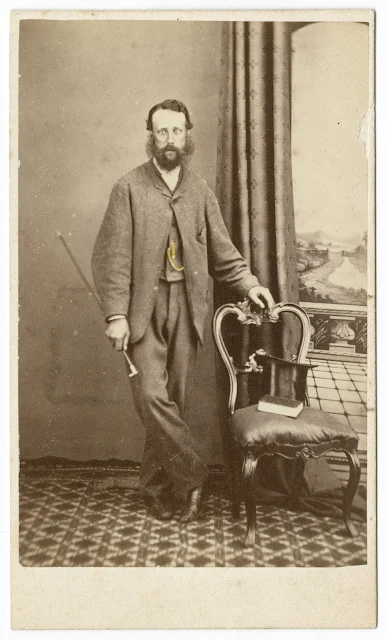
Alfred Barrett Biggs ca, 1872-4 (ca. 45 yrs)
Photographer : Thomas J. Nevin, City Photographic Establishment, Hobart (verso stamp)
Source:Archives Office of Tasmania
View online: LMSS754-1-9
Mary Morrison sent this portrait of herself to her cousin Jane. Her visit to Nevin's studio occurred about the same time as Alfred Barrett Biggs'. Nevin posed them on the same carpet, with the same chair and the same backsheet. The pupils of her eyes, however, were not touched up with black ink, nor was any part of her clothing hand-tinted.

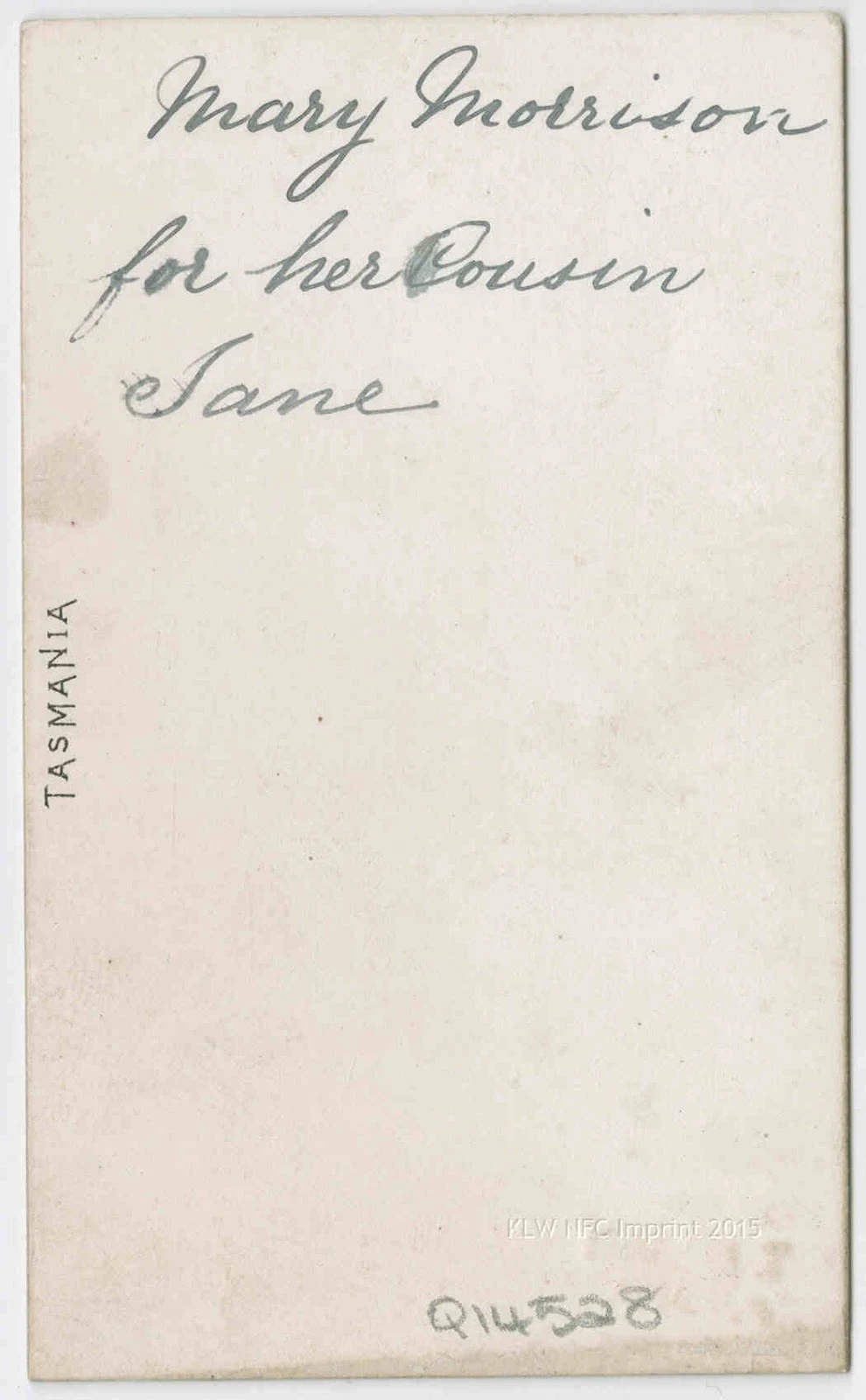
The Tasmanian Museum and Art Gallery Collection
Ref: Q14528 [scan 2015]
Mary Morrison, possibly still in her teens, was a relative of shipowner Askin Morrison, New Wharf. For this portrait, she wore a light summer dress braided at the cuffs, shoulders and V-neck, a dark neckband with brooch, her hair tightly drawn back into a large bun from the part. She might appear to be pouting with shyness, her body and gaze under her lashes directed slightly to the right of the photographer. Nevin photographed her standing next to the dining chair, the drape drawn back to reveal the painted backdrop of a checked patio and Italianate balustrade. The recto is stamped at lower left corner with Nevin's blind stamp impress, "T. NEVIN PHOTO". Verso is inscribed "Mary Morrison for her Cousin Jane", and printed along the left hand side, "Tasmania".


Another studio portrait by Thomas J. Nevin ca. 1870-75, taken at The City Photographic Establishment, 140 Elizabeth St. Hobart, with decor featuring a painted wall hanging with Italianate tiling and balcony giving onto a river scene.
Scans courtesy © The Private Collection of Marcel Safier 2005 ARR
The same distinctive dining chair in Alfred Barrett Biggs' portrait provided support for these two clients.


National Gallery of Victoria Catalogue Notes
No title (woman wearing a bonnet with a pink bow), carte-de-visite (1865-1867)
T. NEVIN, Hobart
Medium albumen silver photograph, watercolour
Measurements 9.5 × 5.8 cm (image and support) Place/s of Execution Hobart, Tasmania
Inscription printed in ink on support on reverse c. AD ALTIORA / CITY PHOTOGRAPHIC ESTABLISHMENT / T. NEVIN. / LATE / A. BOCK. / 140 ELIZABETH ST / HOBART TOWN. / Further copies / can be obtained at / any time.
Accession Number 2003.395 Department Australian Photography Credit Line National Gallery of Victoria, Melbourne
Presented through the NGV Foundation by John McPhee, Member, 2003


Tasmanian Museum and Art Gallery Collection
TMAG Ref: Q2012.28.28
Full length cdv on plain mount:
Elizabeth Bayley, second wife of Captain James Bayley of Runnymede, New Town, Tasmania,
Studio portrait by Thomas Nevin late December 1874.
Verso with studio stamp: “Ad Altiora” above Kangaroo emblem, T. Nevin late A. Bock encircled by belt printed with “City Photographic Establishment” and address below, “140 Elizabeth St. Hobart Town”. In italics below: “Further Copies can be obtained at any time”.
This portrait of Alfred Barnett Biggs' mother, Eliza Biggs née Coleman (1801-1891) was taken in the early 1870s by Thomas Nevin at the City photographic Establishment. The unusual feature of the decor in this portrait is the platform behind her, covered with Nevin's more commonly used lighter coloured tapis (carpet) acquired at auction from Alfred Bock's stock which features in this full-length studio portrait of a girl with bare shoulders and ringlets, 1865. The chair and lower darker floor covering is the same as the mat and chair in the portrait of her son Alfred Barrett and Harriet Biggs playing chess.
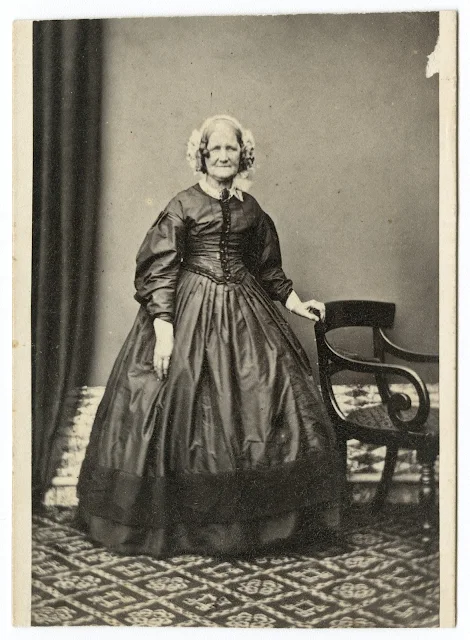
Mrs Eliza Coleman Biggs, wife of Abraham Biggs 1870s
Photographer: Thomas J. Nevin, City Photographic Establishment, Hobart
Source: Archives Office of Tasmania
View online:LMSS754-1-10
A rare pose, this photograph of Alfred Barrett Biggs, his head down contemplating his next move in a game of chess with his wife Harriet née Burville who observes the photographer most keenly standing to his right of the camera, was taken about the same time as the full-length portrait of Alfred's mother Eliza Biggs. Harriet chose to wear a voluminous dress of the sheerest ribbed silk, pin-tucked at the bodice and overlain with a transparent gauze shawl across her shoulders. The tall chess pieces were commonly made from ivory.

Alfred Barrett Biggs and his wife Harriet Burville Biggs early 1870s
Photographer; Thomas J. Nevin, City Photographic Establishment, Hobart
Source: Archives Office of Tasmania
View online LMSS754-1-11
TO LET: STUDIO and GLASS HOUSE 1875
When Abraham Biggs senior died on the 22nd June 1875 at Hawthorn, Melbourne, his second eldest son Abraham Edwin Biggs was the lessor of the premises at 138 and 136-138½ Elizabeth St. Hobart Town, occupied by Thomas J. Nevin since Alfred Bock's departure to Victoria in 1865. The lease on the shop and studio was offered together with the glass house which Bock and Nevin had maintained as a gallery at the rear of the side cart entrance adjacent to the residence.

Right page: January 2, 1874
142 Elizabeth St. Hobart: public house The Royal Standard Hotel, James Spence prop.
140 Elizabeth St. Hobart; James Spence proprietor
136½-138 Elizabeth Street, Hobart:occupier of the property: Thomas J. Nevin
Names and residence of the proprietor: Abraham E. Biggs, Victoria.
Source; Australia, Tasmania, Government Gazette, 1833-1925 SLTX/AO/NP/182: 9 Dec 1873-21 Oct 1874. Image 99
Between the studio, shop front and the residence at 138-140 Elizabeth Street was the glass house with a residence attached, listed variously in The Hobart Town Gazettes of 1872-4 with the address 138½ or 136½ Elizabeth Street, tenanted by Nevin's young apprentice William Ross. In mid 1875, Thomas Nevin ran a series of advertisements for the lease of the shop, studio and glass house as he prepared his family to take up residence at the Hobart Town Hall with his appointment in January 1876 as Hall and Office Keeper to the Hobart City Corporation.
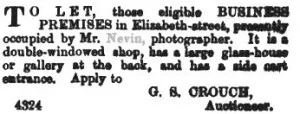
Thomas J. Nevin's shop and glass house TO LET,
The Mercury (Hobart, Tas.)Thu 24 Jun 1875 Page 1 Advertising
TRANSCRIPT
TO LET, those eligible BUSINESS PREMISES in Elizabeth-street, presently occupied by Mr. Nevin, photographer. It is a double-windowed shop, has a large glass-house or gallery at the back, and has a side cart entrance. Apply to G.S. CROUCH, Auctioneer.The glass house was eventually sold to photographer Stephen Spurling elder who auctioned it when he was declared bankrupt in November 1875.

Stephen Spurling elder, bankrupt, sale of photographer's glass house
The Mercury 29 November 1875
Thomas Nevin's neighbour, James Spence, licensee and proprietor of the Royal Standard Hotel at 142 Elizabeth St. right next door to the studio in 1872, was also a government contractor who regularly tendered for construction of roads. He had financed his purchase of the properties at 140 and 142 Elizabeth St., formerly granted to Joseph Lester and Robert Makepeace respectively, with promissory notes from wealthy landowner John Dunn, proprietor of the brewery on the corner of Patrick and Elizabeth Streets, directly opposite.Thomas Nevin sponsored James Spence for the elections of Aldermen to the Hobart City Council in 1872. Not only did Spence fail to gain a seat, he was ridiculed in the press at length for his complaints about the government's abuse of contractors' rights. He sold the Royal Standard Hotel in January 1874 for £775 to John Elliott jnr and retired to Green Ponds where he died, aged 63 yrs in 1884.
In 1878, John Henry Elliott, son of John Nathaniel Elliott who held the licensee of the White Hart Inn decades previously, had not only acquired the lease on Thomas Nevin's old studio at 140 Elizabeth St. Hobart, he was also the proprietor of the public house next door at 142 Elizabeth St., the Royal Standard Hotel, formerly owned by James Spence, while Abraham Edwin Biggs retained ownership of the residence at 138 and 136½ Elizabeth St. until 1886 when he sold that property to the new proprietor Catherine Peck of Brown St. who by then owned the additional adjoining shop, No. 136 as well as Nos. 138-140 Elizabeth St. The rooms were advertised for meetings of phrenology demonstrations in the 1890s, but by 1904 the "cowkeepers and purveyors of milk" in the row of houses and shops next to the old studio, including 136 Elizabeth St, were put on notice by the Board of Health to control the unsanitary practice of keeping cowsheds out the back and storing milk and utensils in the shop (Mercury Tue 14 Jun 1904 Page 2). John Henry Elliott's daughter Dora Tryphena Elliott was married to Alfred Pedder, the collector of a number of portraits and stereographs taken by Thomas J. Nevin, which were donated to the Tasmanian Museum and Art Gallery in the 1970s.
New owner of the Royal Standard Hotel at 142 Elizabeth St. corner of Patrick St. Hobart and former studio at 140 Elizabeth St. Hobart: John Elliott jun. but A. E. Biggs was still the proprietor. of Nos. 138 and 136½ Elizabeth St.
Source: The Hobart Town Gazette VOL. LXIII. TUESDAY, January 1, 1878. N·o. 5204.
These buildings were demolished and the street numbers altered at an unknown date, possibly ca. 1907. The site of James Spence's Royal Standard Hotel at 142 Elizabeth St. on the corner of Patrick St and Elizabeth Sts is now occupied by a modern medical centre, and the site of Thomas Nevin's studio, formerly at No. 140 Elizabeth Street next door is now the head quarters of the Tasmanian Aboriginal Centre, at No. 198 Elizabeth St. Hobart.
Tasmanian Aboriginal Centre at 198 Elizabeth St (new brown block building), formerly Nevin's studio at 140 Elizabeth St.
James Spence's Royal Standard Hotel formerly located on the corner, now a medical centre.
Google maps 2019
Addenda 1: Biography of Alfred Barrett BIGGS (1825–1900)
Source: Australian Dictionary of Biography
http://adb.anu.edu.au/biography/biggs-alfred-barrett-12798
Life Summary [details]
Alfred Barrett BIGGS
Birth 10 April 1825
London, Middlesex, England
Death 19 December 1900
Launceston, Tasmania, Australia
Cultural Heritage English
Religious Influence Methodist Presbyterian
Occupation astronomer inventor school principal schoolteacher scientific instrument maker
Alfred Barrett Biggs (1825-1900), teacher, bank officer, astronomer and inventor, was born on 10 April 1825 in London, eldest son of Abraham Biggs, carpenter, and his wife Eliza, née Coleman. In 1833 the family moved to Van Diemen's Land. Abraham's involvement in Methodism and eventually in the teaching profession was to have a strong influence on Alfred, who took up a tutoring position at Bothwell in 1845. Three years later he became a bank clerk in Hobart Town, but left for Melbourne in 1852, continuing in banking then returning to teaching. On 22 February 1855 at Melville Street Wesleyan Chapel, Hobart, Biggs married Harriet Burville. In 1858 he became headmaster of the Hoddle Street School, Melbourne. The family returned in 1864 to Tasmania, where Biggs again took a teaching post at Bothwell. In 1872 they moved to Campbell Town. There he taught in the public school and befriended Dr William Valentine. Both men were fascinated by astronomy and in 1874 a rare astronomical event occurred: the transit of Venus. Valentine had invited an American expedition to view the transit from his home. Biggs assisted with the observations and the Americans gave him a building they had used in making their observations.
In 1877 Biggs learned of the invention of the telephone. He then constructed a pair of telephones and had them connected between Launceston and Campbell Town, successfully transmitting sounds between the two locations. It has been claimed that this was the first telephone connection in Australia. About 1879 he moved to Launceston and took a position as accountant and ledger-keeper with the Launceston Bank for Savings. His continuing interest in astronomy led to the construction of an observatory in the western part of the city. Despite the small size of his telescopes—his instruments were then a 2-inch (51-mm) and a 3-inch (76-mm) refractor—Biggs was a diligent and pedantic observer, becoming known as Launceston's 'Astronomer Royal'. He contributed reports to the local newspaper and from 1884 papers to the Royal Society of Tasmania, of which he was that year elected a fellow. He made observations and measurements of comets, double stars, eclipses and transits of Mercury and Venus (another transit of Venus occurred in 1882). In 1885 he came into possession of an 8½ inch (216-mm) diameter reflecting telescope, originally owned by Valentine.
Biggs had a reputation as an inventor and instrument maker. He constructed a microscope—grinding the lenses himself—and both a vertical and a horizontal seismometer; his interest in seismology was likely to have been aroused by Launceston's small earth tremors about 1880. Other devices he made included an observatory clock driven by a float and micrometers to measure angular separations, such as the apparent distance between double stars, through the telescope. For the detection of counterfeit coins he invented a coin tester.
His devotion to religious activities was lifelong. At St Andrew's Presbyterian Church, Launceston, Biggs played the organ and conducted the choir; he composed at least three hymns. He saw no conflict between religion and science. When he was a teacher, he had some difficult times with the Board of Education. However, his thin, bearded face was suggestive of a man with a sense of humour. A frequent writer of letters to the press, he was a committee member and sometime president and treasurer of the Launceston Mechanics' Institute. Predeceased by his wife, Biggs died on 19 December 1900 at his residence above the bank and was buried in the general cemetery. Six of his eight children survived him. A 1935 memorial to Biggs stands in Royal Park, Launceston, near the former site of his observatory.
Select Bibliography
M. Giordano, Watcher of the Skies (Launc, Tas, 1995)
Papers and Proceedings of the Royal Society of Tasmania, 1933
Records of the Queen Victoria Museum Launceston, no 89, 1985
Examiner (Launceston), 29 Sept 1886, p 2, 20 Dec 1900, p 7
Biggs family papers (Archives Office of Tasmania)
private information.
Citation details:
Martin George, 'Biggs, Alfred Barrett (1825–1900)', Australian Dictionary of Biography, National Centre of Biography, Australian National University, http://adb.anu.edu.au/biography/biggs-alfred-barrett-12798/text23097, published first in hardcopy 2005, accessed online 6 September 2019.
Addenda 2: Writings of Alfred Barrett Biggs
Source: University of Tasmania Open Access Repository
Biggs, Alfred Barrett 1887 , 'Alpha Centauri, with a graphic projection of its orbit from its apparent curve' , Papers & Proceedings of the Royal Society of Tasmania , pp. 79-82 .
Biggs, Alfred Barrett 1885 , 'Eclipse of March 30-31, 1885' , Papers & Proceedings of the Royal Society of Tasmania , p. 309 .
Biggs, Alfred Barrett 1886 , 'Is Jupiter self-luminous?' , Papers and Proceedings of the Royal Society of Tasmania , pp. 33-38 .
Biggs, Alfred Barrett 1884 , 'Notes of spectroscopic observations of comet “pons," 27th January to 2nd February, 1884' , Papers & Proceedings of the Royal Society of Tasmania , pp. 200-201 .
Biggs, Alfred Barrett 1889 , 'Observations of comet of July and August, 1889, taken at Launceston, Tasmania, Lat. 41 degrees 26' 01" : Long. 9 degrees 48'31" East.' , Papers & Proceedings of the Royal Society of Tasmania , p. 105 .
Biggs, Alfred Barrett 1884 , 'Observations on Mr. R. M. Johnston's vital statistics' , Papers & Proceedings of the Royal Society of Tasmania , pp. 276-280 .
Biggs, Alfred Barrett 1866 , 'The Occulation of Jupiter' , Papers and Proceedings of the Royal Society of Tasmania .
Biggs, Alfred Barrett 1889 , 'Recent measures of " A. Centauri."' , Papers & Proceedings of the Royal Society of Tasmania , p. 106 .
Biggs, Alfred Barrett 1892 , 'Remarks on Sir Robert Ball's paper (Read at the Hobart meeting of the Australasian Science Association), entitled : " The astronomical explanation of a glacial period."' , Papers & Proceedings of the Royal Society of Tasmania , pp. 21-25 .
Biggs, Alfred Barrett 1884 , 'Report of spectroscopic observation of the twilight glows during February and March, 1884' , Papers & Proceedings of the Royal Society of Tasmania , pp. 202-203 .
Biggs, Alfred Barrett 1885 , 'Tasmanian earth tremors, 1883-4-5' , Papers & Proceedings of the Royal Society of Tasmania , pp. 325-334 .
Biggs, Alfred Barrett 1891 , 'Total eclipse of the moon, 24th May, 1891, observed at Launceston' , Papers & Proceedings of the Royal Society of Tasmania , pp. 44-45 .
Biggs, Alfred Barrett 1887 , 'The comets of February, 1880 and January, 1887' , Papers & Proceedings of the Royal Society of Tasmania , pp. 38-39 .
Biggs, Alfred Barrett 1889 , 'A new dark-field micrometer for double-star measurement' , Papers & Proceedings of the Royal Society of Tasmania , pp. 98-101 .
Biggs, Alfred Barrett 1891 , 'The possibility of the telescope' , Papers & Proceedings of the Royal Society of Tasmania , pp. 18-24 .
Biggs, Alfred Barrett 1891 , 'The transit of Mercury, May 10, 1891' , Papers & Proceedings of the Royal Society of Tasmania , pp. 46-48 .
Addenda 3: later portraits of Alfred Barrett Biggs
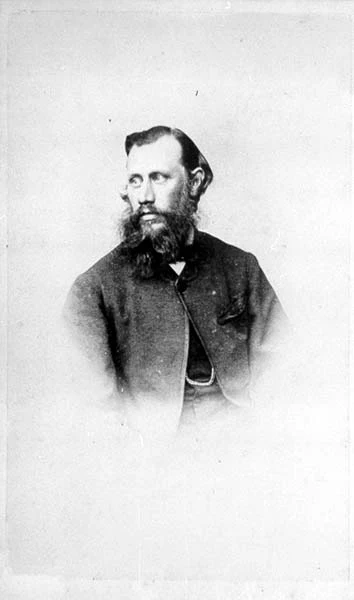
Photographic portrait of BIGGS, Alfred Barett
Start Date: 01 Jan 1880 (age ca. 55 yrs)
Source: Archives Office of Tasmania
View online:PH30-1-2892
This portrait (below) of Alfred Barrett Biggs was taken in 1891. It was duplicated and mounted on each of his season tickets as a "passport" for admission to the events of The Tasmanian Exhibition of 1891-92 held at Launceston.


Left: Alfred Barrett Biggs 1891 (ca. 66 yrs old)
Source: Launceston Family Album
Right: Cover of John B Biggs (2011) Tasmania over five generations: Return to Van Diemen's Land ?, Forty Degrees South Pty Ltd. Sourced at John Bigg's website
These portraits appear in the comprehensive historical account of the Biggs family over five generations by John Biggs, published in 2011.

Portrait of Alfred Barrett Biggs 1894 (age ca. 70 yrs)
Photographer: Stephen Spurling, Launceston]
Item Number: LMSS754/1/13
Source: Archives Office of Tasmania
View online: LMSS754-1-13
RELATED POSTS
- On the road with Sam Clifford and Thomas Nevin 1874
- Alfred Bock's stock-in-trade
- Alfred Bock's other apprentice: William Bock
- Portraits of Older Women by Thomas J. Nevin
- One of the last portraits by Alfred Bock in Hobart 1865
- Elizabeth Bayley at Runnymede, New Town 1874-1875
- Thomas Nevin's portraits of his wife Elizabeth Rachel
- T.J. Nevin's portraits of the McVilly children 1874
- Nevin's women clients and their dresses 1870s
- Thomas Nevin's stereo view of St Mary's Cathedral, Hobart, ca. 1874



















